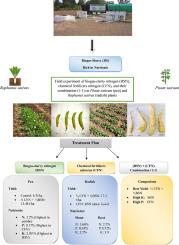通过混合使用生物浆和化肥提高农业可持续性:豌豆和萝卜田间试验的见解
Q1 Environmental Science
引用次数: 0
摘要
沼气浆(BS)是厌氧消化的副产品,富含营养,有望成为化肥的可持续替代品。本研究评价了BS、化肥氮(CFN)及其组合(1,1)对豌豆(Pisum sativum)和萝卜(Raphanus sativus)生长和产量的影响。组合处理(1 / 2 CFN + 1 / 2 BSN)两种作物的产量最高,豌豆为12.48 t·ha - 1,萝卜为17.3 t·ha - 1,显著超过对照处理。在豌豆中,组合处理籽粒氮含量最高(2.2%),CFN和BSN处理籽粒磷含量最高(0.17%),钾含量最高(2.09%)。配施处理下萝卜植株的根、茎中氮、磷、钾含量最高。经济分析表明,CFN与BSN综合施用的效益最高,豌豆的价值成本比为16.0,萝卜的价值成本比为9.7。这些结果表明,将BS与CFN相结合可以提高作物生产力,改善养分吸收,减少对合成肥料的依赖,有助于实现更可持续的农业实践。本文章由计算机程序翻译,如有差异,请以英文原文为准。

Enhancing agricultural sustainability through the combined use of bio-slurry and chemical fertilizers: Insights from field trials in pea and radish
Biogas slurry (BS), a by-product of anaerobic digestion, is rich in nutrients and holds promise as a sustainable alternative to chemical fertilizers. This study evaluated the effects of BS, chemical fertilizer nitrogen (CFN), and their combination (1, 1) on the growth and yield of Pisum sativum (pea) and Raphanus sativus (radish). The combined treatment (½ CFN + ½ BSN) produced the highest yields for both crops—12.48 t·ha−1 for peas and 17.3 t·ha−1 for radish—significantly surpassing control treatments. In peas, the highest grain nitrogen content (2.2 %) occurred under the combined treatment, while CFN and BSN resulted in the highest phosphorus (0.17 %) and potassium (2.09 %) contents, respectively. Radish plants also showed maximum N, P, and K concentrations in shoots and roots under the combined treatment. Economic analysis revealed that the integrated application of CFN and BSN treatment had the highest profitability, with a value-cost ratio of 16.0 for peas and 9.7 for radish. These results suggest that integrating BS with CFN can enhance crop productivity, improve nutrient uptake, and reduce reliance on synthetic fertilizers, contributing to more sustainable agricultural practices.
求助全文
通过发布文献求助,成功后即可免费获取论文全文。
去求助
来源期刊

Bioresource Technology Reports
Environmental Science-Environmental Engineering
CiteScore
7.20
自引率
0.00%
发文量
390
审稿时长
28 days
 求助内容:
求助内容: 应助结果提醒方式:
应助结果提醒方式:


